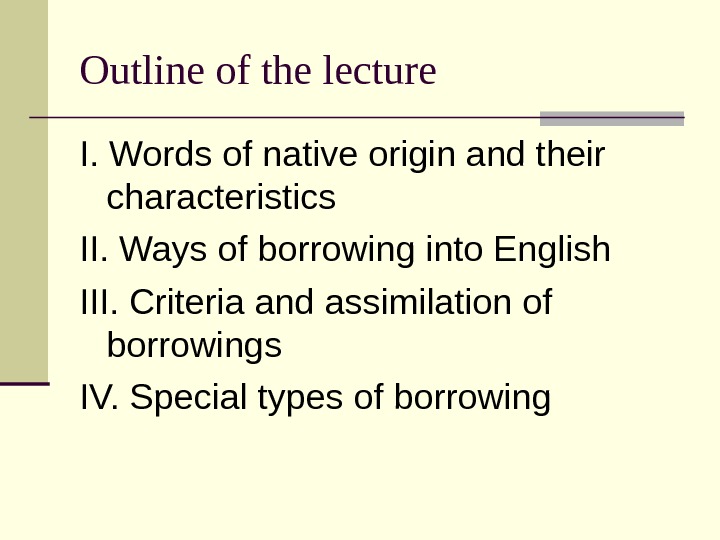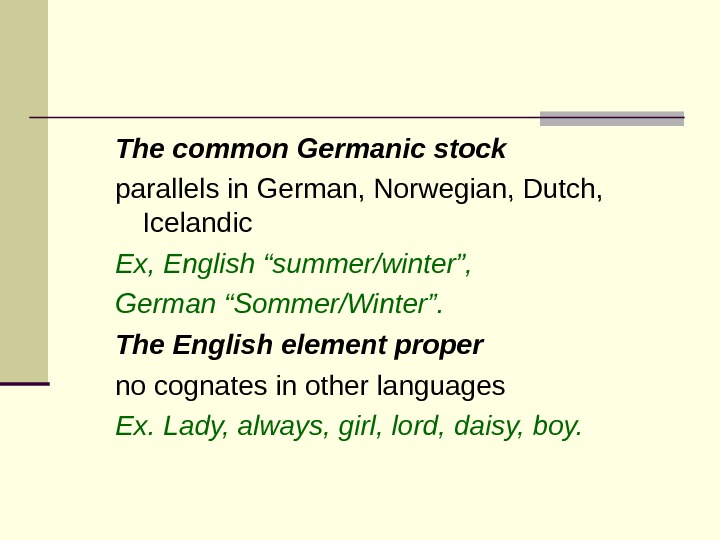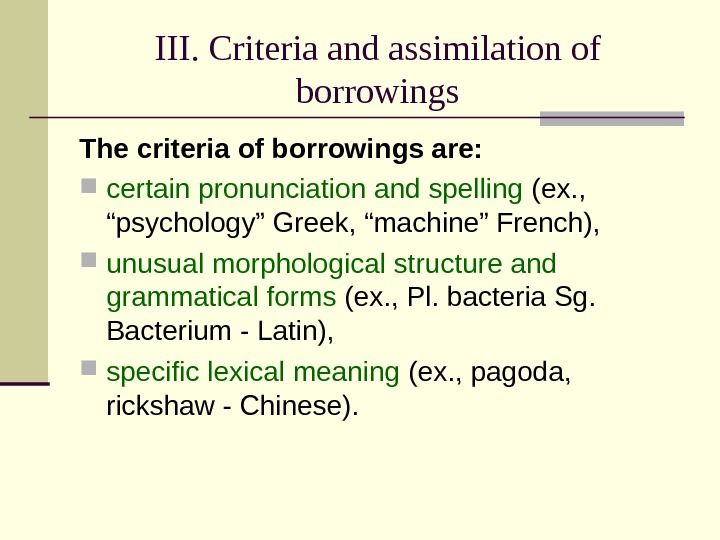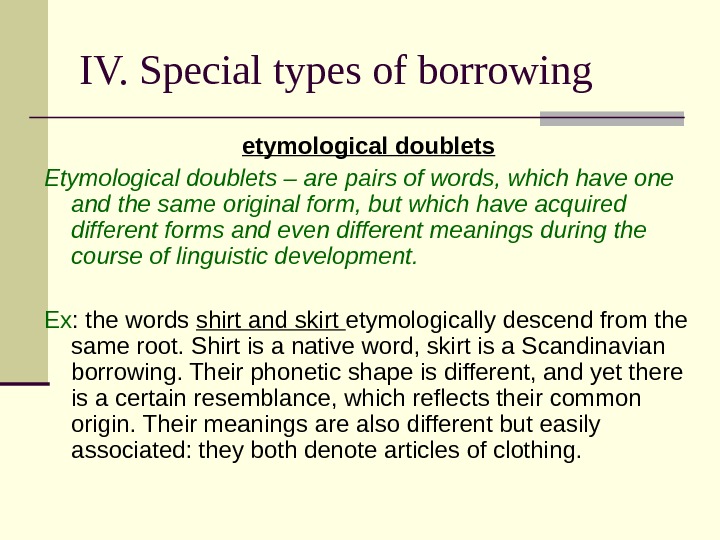Lexicology Lecture 3. Etymological composition of the













12-03-2012_20_21_new_lecture_3.ppt
- Размер: 204 Кб
- Количество слайдов: 13
Описание презентации Lexicology Lecture 3. Etymological composition of the по слайдам
 Lexicology Lecture 3. Etymological composition of the English word-stock
Lexicology Lecture 3. Etymological composition of the English word-stock
 Outline of the lecture I. Words of native origin and their characteristics II. Ways of borrowing into English III. Criteria and assimilation of borrowings IV. Special types of borrowing
Outline of the lecture I. Words of native origin and their characteristics II. Ways of borrowing into English III. Criteria and assimilation of borrowings IV. Special types of borrowing
 1. 1. Words of native origin and their characteristics Anglo-Saxon origin the British Isles the Germanic tribes (the Angles, the Saxons and the Jutes) 1. Words of the Indo-European stock, 2. words of the common Germanic origin, 3. English words proper. ________________ Ex, English “star”, German “Stern”, Latin “Stella”, Greek “Aster”.
1. 1. Words of native origin and their characteristics Anglo-Saxon origin the British Isles the Germanic tribes (the Angles, the Saxons and the Jutes) 1. Words of the Indo-European stock, 2. words of the common Germanic origin, 3. English words proper. ________________ Ex, English “star”, German “Stern”, Latin “Stella”, Greek “Aster”.
 Semantic groups of words of the Indo-European stock : terms of kinship (father, mother, daughter), natural phenomena (Sun, Moon, star, wind, storm), names of animals and birds (horse, goose), parts of human body (heart, eye, foot), qualities and properties (old, young, cold), common actions (come, sit, stand).
Semantic groups of words of the Indo-European stock : terms of kinship (father, mother, daughter), natural phenomena (Sun, Moon, star, wind, storm), names of animals and birds (horse, goose), parts of human body (heart, eye, foot), qualities and properties (old, young, cold), common actions (come, sit, stand).
 The common Germanic stock parallels in German, Norwegian, Dutch, Icelandic Ex, English “summer/winter”, German “Sommer/Winter”. The English element proper no cognates in other languages Ex. Lady, always, girl, lord, daisy, boy.
The common Germanic stock parallels in German, Norwegian, Dutch, Icelandic Ex, English “summer/winter”, German “Sommer/Winter”. The English element proper no cognates in other languages Ex. Lady, always, girl, lord, daisy, boy.
 II. Ways of borrowing into English A loan word or a borrowing is a word taken over from another language and modified in phonemic shape, spelling paradigm or meaning according to the standards of the English language. 2 ways: through oral speech, Ex. Old borrowings from Latin: inch, mill, street through written speech. (French “belles-lettres”)
II. Ways of borrowing into English A loan word or a borrowing is a word taken over from another language and modified in phonemic shape, spelling paradigm or meaning according to the standards of the English language. 2 ways: through oral speech, Ex. Old borrowings from Latin: inch, mill, street through written speech. (French “belles-lettres”)
 III. Criteria and assimilation of borrowings The criteria of borrowings are: certain pronunciation and spelling (ex. , “psychology” Greek, “machine” French), unusual morphological structure and grammatical forms (ex. , Pl. bacteria Sg. Bacterium — Latin), specific lexical meaning (ex. , pagoda, rickshaw — Chinese).
III. Criteria and assimilation of borrowings The criteria of borrowings are: certain pronunciation and spelling (ex. , “psychology” Greek, “machine” French), unusual morphological structure and grammatical forms (ex. , Pl. bacteria Sg. Bacterium — Latin), specific lexical meaning (ex. , pagoda, rickshaw — Chinese).
 3 main ways : phonetic assimilation comprising changes in the sound, form and stress (ex. , German “Spitz”/ English “Spitz”), grammatical assimilation causing the loss of former grammatical categories and affixes and the acquirement of new paradigms (ex. , Latin “botanicus” was turned into English “botanical”), semantic assimilation comprising adjustment to the system of meanings of the voc-ry (ex. , “gay” was borrowed from French with several meanings: noble of birth, bright shining, multicolored. Now it means “joyful” or “high-spirited”).
3 main ways : phonetic assimilation comprising changes in the sound, form and stress (ex. , German “Spitz”/ English “Spitz”), grammatical assimilation causing the loss of former grammatical categories and affixes and the acquirement of new paradigms (ex. , Latin “botanicus” was turned into English “botanical”), semantic assimilation comprising adjustment to the system of meanings of the voc-ry (ex. , “gay” was borrowed from French with several meanings: noble of birth, bright shining, multicolored. Now it means “joyful” or “high-spirited”).
 Loan-words fall into 3 groups : According to the degree of assimilation loan-words fall into 3 groups : 1. completely assimilated words (ex. , French “pain” is readily combined with native affixes “pained, painful, painless”),
Loan-words fall into 3 groups : According to the degree of assimilation loan-words fall into 3 groups : 1. completely assimilated words (ex. , French “pain” is readily combined with native affixes “pained, painful, painless”),
 2. partially assimilated words that may be: a) not assimilated semantically (ex. , sombrero), b) not assimilated grammatically (ex. , borrowings from Latin, Greek: formula/ae), c) not assimilated phonetically (prestige, memoir — French), d) not assimilated graphically (ex. , the final silent “t” in ballet — French).
2. partially assimilated words that may be: a) not assimilated semantically (ex. , sombrero), b) not assimilated grammatically (ex. , borrowings from Latin, Greek: formula/ae), c) not assimilated phonetically (prestige, memoir — French), d) not assimilated graphically (ex. , the final silent “t” in ballet — French).
 3. barbarisms Words from other languages used by English people in conversation or in writing but not assimilated in any way and for which there are corresponding English equivalents (ex. , chaos, adios).
3. barbarisms Words from other languages used by English people in conversation or in writing but not assimilated in any way and for which there are corresponding English equivalents (ex. , chaos, adios).
 IV. Special types of borrowing etymological doublets Etymological doublets – are pairs of words, which have one and the same original form, but which have acquired different forms and even different meanings during the course of linguistic development. Ex : the words shirt and skirt etymologically descend from the same root. Shirt is a native word, skirt is a Scandinavian borrowing. Their phonetic shape is different, and yet there is a certain resemblance, which reflects their common origin. Their meanings are also different but easily associated: they both denote articles of clothing.
IV. Special types of borrowing etymological doublets Etymological doublets – are pairs of words, which have one and the same original form, but which have acquired different forms and even different meanings during the course of linguistic development. Ex : the words shirt and skirt etymologically descend from the same root. Shirt is a native word, skirt is a Scandinavian borrowing. Their phonetic shape is different, and yet there is a certain resemblance, which reflects their common origin. Their meanings are also different but easily associated: they both denote articles of clothing.
 International words (ex. , gene, antibiotic). Translation loans (ex. , English “wall newspaper” from Russian “ стенная газета ”) The semantic loan Ex. , English “pioneer” originally meant “explorer”. Under the influence of Russian word it has come to mean “a member of the young pioneer organization”.
International words (ex. , gene, antibiotic). Translation loans (ex. , English “wall newspaper” from Russian “ стенная газета ”) The semantic loan Ex. , English “pioneer” originally meant “explorer”. Under the influence of Russian word it has come to mean “a member of the young pioneer organization”.
